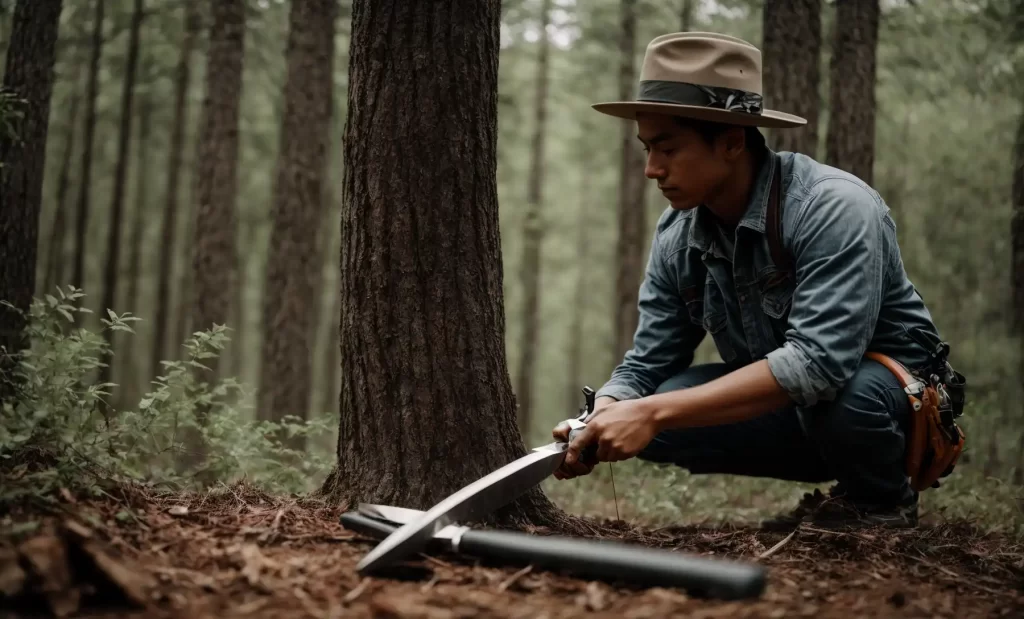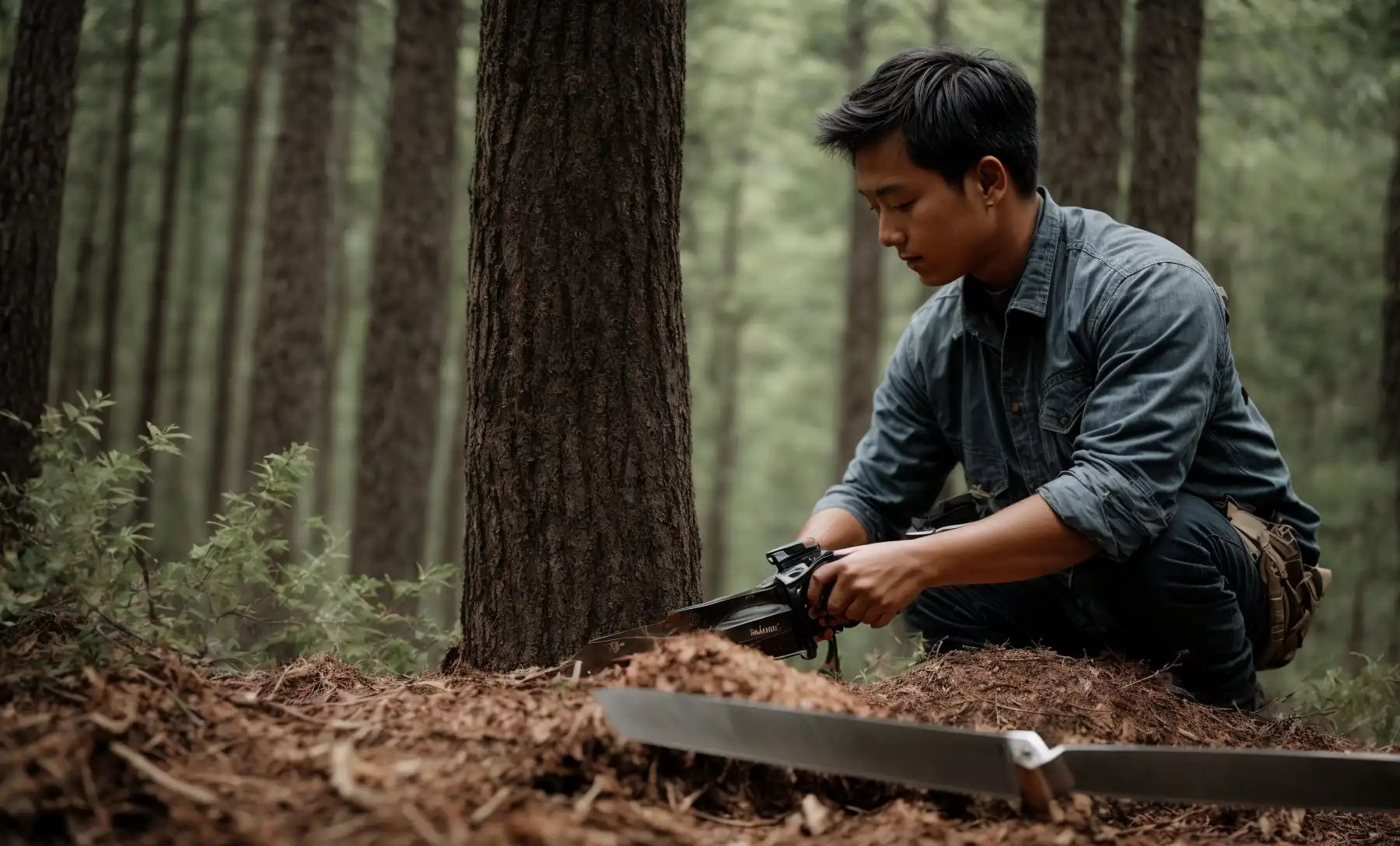To cut down a small tree without a chainsaw, use handsaws, pruning saws, or a hatchet. Ensure you have clear ground and a planned direction for the tree to fall.
Cutting down a small tree might seem like a challenge without the power of a chainsaw, but with the right tools and technique, it’s entirely manageable. The absence of chainsaw’s roar makes the process quieter and can be safer for those unaccustomed to power tools.
Choosing a sharp, well-maintained handsaw or hatchet is crucial for a clean cut. Safety measures, such as wearing protective gear and ensuring a clear escape path, are paramount. This manual method not only provides the satisfaction of physical work but also offers a quieter, eco-friendly alternative to tree removal. With careful planning and execution, the task can be completed efficiently, keeping your garden or property well-managed and aesthetically pleasing.
About Tree Removal Basics
Removing a small tree from your yard isn’t always about using a chainsaw. Certain situations call for alternative methods. This section explains safe non-chainsaw techniques for tree cutting. From understanding why it’s crucial to cut safely to discussing the tools needed, we’ve got it covered.
Understanding the Need for Safe Tree Cutting
Safety is the top priority when it comes to tree removal. Risks include property damage and personal injury. Learning proper techniques and using the right tools is essential. It ensures the job gets done without harm.
Overview of Tools for Non-chainsaw Tree Removal
- Hand saw: Sharp and effective for smaller branches.
- Bow saw: Ideal for branches with greater diameters.
- Axe: Traditional yet efficient for cutting down small trees.
- Loppers: Perfect for thin branches, allowing precise cuts.
- Pruning saw: Designed to handle branches that hand saws can’t.
Preparation Before Cutting
Taking down a small tree by hand calls for attention to detail and proper preparation. Correct methods ensure safety and effectiveness during the process.
Assessing Tree Health and Stability
Begin with examining the tree for signs of disease or weakness. This helps in determining the safest method to cut it.
- Check for dead branches that can fall unexpectedly.
- Look for any decay at the tree’s base.
- Ensure that the tree can be cut safely without collapsing.
Choosing the Correct Time and Weather Conditions
Picking the right moment is critical. Ideal conditions are crucial for a safe and efficient cut.
- Avoid windy days to prevent unpredictable falls.
- Opt for a clear, dry day for better grip and visibility.
- Ensure enough daylight for the entire process.
Safeguarding the Surrounding Area and Personal Safety Gear
Protecting the environment and yourself comes next. Preparing the area minimizes potential hazards.
| Area Safeguards | Personal Safety Gear |
|---|---|
| Clear the base of the tree from debris. | Wear a hard hat to protect your head. |
| Create a clear zone where the tree will fall. | Use safety goggles to shield your eyes. |
| Alert others to keep a safe distance. | Ear protection is vital against noise. |
| Plan an escape route in case of shifts. | Heavy-duty gloves improve grip and protect hands. |
With these preparations, you’re ready to remove a small tree safely, without a chainsaw. Follow these steps diligently to ensure a smooth operation.
Step-By-Step Guide to Cutting Down a Tree
Cutting down a small tree does not always require a chainsaw. With proper techniques and tools, such as hand saws and axes, anyone can safely and effectively cut down a tree. Follow this step-by-step guide to learn how.
Notching and Scoring Methods Without a Chainsaw
Notching and scoring help control the direction of a tree’s fall. Even without a chainsaw, this can be achieved. Begin by making a notch on the side of the tree where you want it to fall. Cut a wedge-shaped notch at about knee-height, cutting one-third into the tree. Then, make a horizontal cut on the opposite side, slightly above the bottom of the notch, to score the tree.

Leveraging Hand Saws, Axes, and Alternative Tools
- Choose a sharp hand saw or axe suited to the tree’s diameter.
- Begin with the notch as outlined above.
- For larger trees, consider a crosscut saw which requires two people.
- Use a wedge and hammer to assist in controlling the fall after scoring.
Techniques to Control the Direction of the Tree’s Fall
- Plan the tree’s fall path, ensuring it’s clear of obstacles and targets.
- Make precise cuts using the notching technique described.
- Insert wedges into the back cut to prevent the saw from binding and to direct the fall.
- Keep a safe distance as the tree begins to fall.
Post-cutting Procedures
After safely cutting down a small tree without a chainsaw, the next steps ensure a clean and environmentally friendly area. It’s essential to handle the remaining tree parts responsibly. We’ll review how to dispose of the tree, remove the stump, and tidy up the site post-cutting.
Disposing of the Tree and Environmental Considerations
Think green when disposing of the tree. Recycling the wood and foliage is both eco-friendly and beneficial.
- Compost small branches and leaves to nurture garden beds.
- Transform larger logs into furniture or firewood, if suitable.
- Contact local wood recycling facilities or landscaping companies.
Local regulations might dictate specific disposal methods. Always adhere to these guidelines to protect the environment.
Stump Removal Techniques Without Heavy Machinery
Removing a stump can be challenging but achievable. Utilize these strategies:
- Dig around the stump, exposing roots.
- Sever the roots using a handsaw or axe.
- Leverage the stump out with a landscaping bar.
For tougher stumps, consider renting a stump grinder or hiring a professional service. Organic methods such as soil bacteria products that decompose wood are also available.
Site Cleanup and Safety Inspection
Table: Safety Checklist
| Task | Details | Check |
|---|---|---|
| Remove debris | Pick up all wood pieces and foliage. | [ ] |
| Check for hazards | Ensure no sharp objects or tripping risks remain. | [ ] |
| Inspect surrounding trees | Make sure no damage occurred to nearby trees. | [ ] |
Fill in any holes left from the stump removal to prevent accidents. Review local guidelines for final site inspection practices.
Learn more: How to Hollow Out a Stump With a Chainsaw
Conclusion
Felling a small tree can be straightforward with the right tools and techniques. By following these steps, you’ll achieve a safe, clean cut sans chainsaw. Remember, safety is paramount, and always consult a professional for larger or more complex tasks.
Embrace the challenge and enjoy the satisfaction of manual work in your garden. Join our journey at Chainsaw Hive. In our Knowledge space, we uncover the secrets and skills every chainsaw enthusiast should know.
